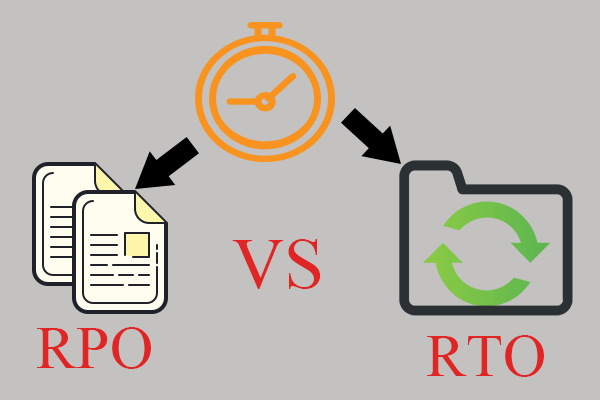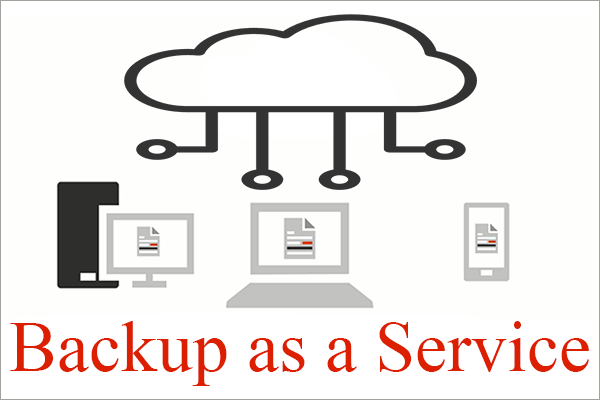Nowadays, the world is driven by data. So, data is of great importance in our daily life, working, learning, entertainment, etc. Nobody wants to lose data especially the vital part. If unfortunately, you get some files lost, you may suffer a lot including but not limited to data gaps, analysis and result discrepancies, financial loss, more work…
Therefore, it is strongly recommended that you have your data backed up using one of the two types of backups, hot backup or cold backup.
What Is a Hot Backup?
Hot backup, also called online backup or dynamic backup, is a backup created for data when the database is actively online and accessible to users. It is the standard way to back up most databases such as MySQL.
Hot backup is performed in near real-time when the system is still running and new data is continuously generated. It is similar to near-continuous data protection. In a hot backup, a time parameter involves in deciding when to carry out a backup, which can range from seconds to minutes.
In a hot backup, the whole data is duplicated on the secondary location. Therefore, the relevant data changes are reflected in the new backup. Hot online backup is a little bit source-intensive for multiple iterations stored at a time, which enables users to restore the backup to a required point. Only when users give their permissions, the old backup versions can be deleted.
The biggest advantage of hot backup is business continuity. When a hot dynamic backup is processing, you can continue your business since your database is still available. Actually, it is always available without other accidents.
Oracle is the major vendor of hot backup services. Yet, it isn’t the only one. Oracle Backup Manager and Recovery Manager are the most popular tools to back up and restore a database. Its users can log in to it and let it back up the database easily. Besides, Oracle Backup Manager can write backup sets to disks or tapes.
About Warm Backup
In a warm backup, the server is powered on but not starting any operations; or, the server is turned on from time to time to get updates from the server being backed up. Warm backups are often applied for mirroring or replication.
What Is a Cold Backup?
Clod backup, usually known as offline backup or static backup, is a kind of backup service that requires the entire data system to be down completely. No business can be done during cold backup. So, it is usually performed at the beginning or end of the day to keep business continuity at most.
For cold backup, a single backup version is created. Due to no new data is added to this backup version in real-time, the backup is done swiftly and only once.
A cold backup can be stored to another disk on the server where the database resides. Yet, if the server is down, the backup will also be gone. To avoid such a thing, cold backup images are usually saved to disk on a different server or to tapes.
USB flash drives or external hard disks can also be used to store cold backup image files. To prevent from damage causing by server crashes, it is recommended to unplug the USB or external disk from the server after the backup completes. Yet, you have to reconnect the drive to the server before each subsequent backup.
Cold backup consumes fewer resources. Yet, it disables users from accessing the database while the backup is building. Data access from the front-end is completely shut off.
Hot Backup vs Cold Backup (Online Backup vs Offline Backup)
The following will compare offline backup and online backup to show you the differences between them.
1. Hot versus Cold Backup: Convenience
Hot backup offers a convenient solution in multiuser systems since it doesn’t ask for downtime as a clod backup does. On the contrary, cold backup needs to stop the whole system including the applications to perform a backup process. It has a feature to shut the system and pause the apps.
2. Cold Backup vs Hot Backup: Security
Though hot backup is very convenient for users to make a copy of their data without interrupting their normal work, it involves certain risks. If the data is changed during the process of backup, the backup copy won’t match the final state of the data.
Besides, hot backup consumes read IOPS and can influence database performance if it is running while the data storage is already under pressure. Users may experience a temporary system or network slowdown.
As for cold offline backup, those risks don’t exist. Clod backups can’t be interrupted by an intruder or virus. They are immune to power surges or electrical interruptions. Moreover, cold storage backup prevents accidental overwrites or deletions.
3. Hot Backup vs Cold Backup: Disaster Recovery (DR)
Clod backup sites aren’t expensive to maintain. They are little more than an appropriately configured space in a building where everything required to return service to users must be obtained and then delivered to the site before the recovery process can begin. The delay involved when moving from a cold backup site to full operation can be lengthy.
On the contrary, the hot backup servers receive ongoing updates from the production server. They are ready to take over immediately after an accident takes down the production server.
The following is a table comparing the differences between a hot backup and cold backup.
| Backup type | Hot backup | Cold backup |
| System state requirement | Dynamic state | Consistent state |
| Database availability | Yes | No |
| Resource-intensive | Yes | No |
| Backup speed | Slow | Fast |
| Recovery time | Short | Long |
| Business continuity | Yes | No |
| Perform time | Anytime | Usually at the start/end of the day |
| Alias | Online backup/dynamic backup | Offline backup/static backup |
Hot Backup vs Cold Backup – Which to Choose?
Both cold backup and hot backup have their pros and cons. Organizations have to figure out which kind of backup suits them most. When choosing a backup type, an IT administrator needs to consider the downtime and comprehensive nature of a cold backup with the ability to keep apps available and productive via a hot data backup.
A hybrid backup takes advantage of app-ware snapshots and data protection to create a momentary pause and disruption to the app. The application continues to work, creating a virtual backup window.
When considering backup or disaster recovery sites, especially for failover and hot backup situations, it’s crucial to think about the geographic scope of potential disasters. Disaster recovery and business continuity professionals should look for sites that are at least 100 miles away, which keeps regional or local disasters from knocking out a backup site as well as the primary site.
If you are an organization with business operations working around the clock and can’t permit any downtime or interruption, then a hot backup is better for you. It allows you to back up your data while keeping business going on.
If you are running a company that has a fixed working time and doesn’t need to be online all the time, the cold backup is your choice. When you are off work, you can perform a cold backup of your company data particularly the data generated today. Or, before you start a day of work, you can carry out a cold backup in case any accident happens during work today.
Perform a Hot Backup with a Reliable Backup Service – MiniTool ShadowMaker
After distinguishing between the hot and cold backup and make your decision to choose hot backup, now, you need to choose a professional and powerful hot backup software to help you protect your data. Here, the well-known MiniTool ShadowMaker is recommended especially for personal computer users.
MiniTool ShadowMaker can back up and restore files/folders, partitions/volumes, operating systems, and the entire hard disks while you are still using your device. The backup carried out by MiniTool ShadowMaker won’t take much of your computer resources and you can make it run in the background.
Now, let’s see how to create a hot backup with MiniTool ShadowMaker. Just a few clicks and you will secure your crucial data with a hot backup that allows you to recover the target data anytime once the original one is lost or damaged!
MiniTool ShadowMaker TrialClick to Download100%Clean & Safe
1. Download, install, and launch MiniTool ShadowMaker on your PC.
2. If it asks for purchase, just click the Keep Trial option in the upper right of the screen.
3. Then, it will enter into its main interface. There, click Backup in the top menu.
4. In the Backup tab, click the Source module to select the data you want to protect, files/folders, partitions, or the whole disk. If you want to clone your system, just keep the default selection; system-related objects are selected by the program itself. Then, click OK to save your selection.
5. Click the Destination module to pick up a location to save the hot backup image. You can back up to internal, external, and even network-attached storage.
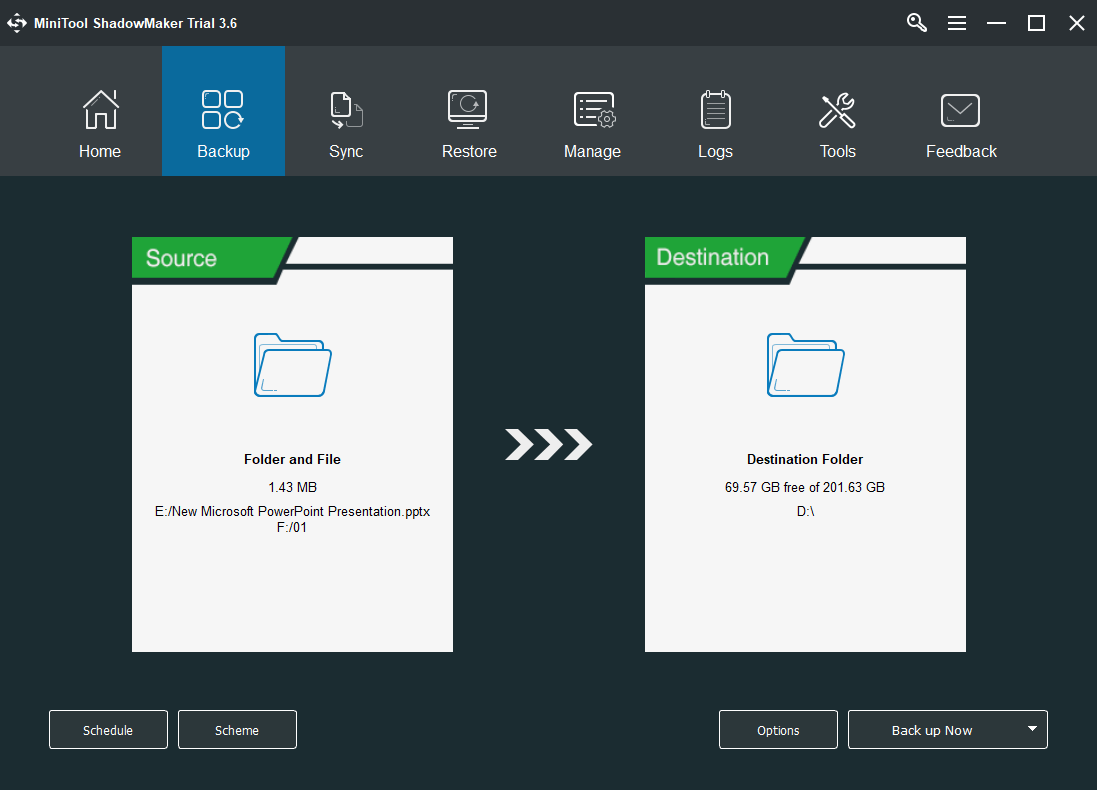
6. You are allowed to create a schedule to automatically back up the selected items with a set frequency (daily, weekly, monthly, or when system log on/log off) in the future. Just click the Schedule button in the bottom left corner, switch on the schedule settings in the pop-up window, and make your decision. If you don’t want a scheduled backup, just skip this step.
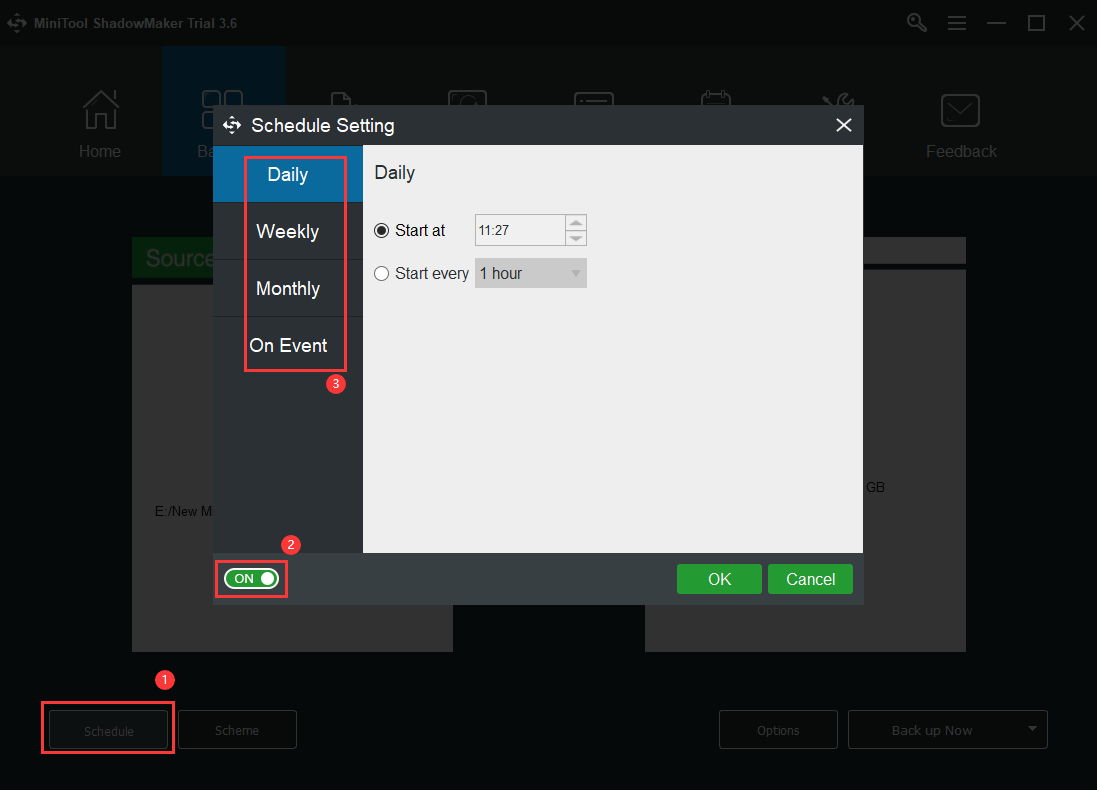
7. Besides, you can set a method for your hot backup by clicking the Scheme button next to the Schedule button. Turn on the backup scheme in the new popup and select a backup method (full, incremental, or differential backup).
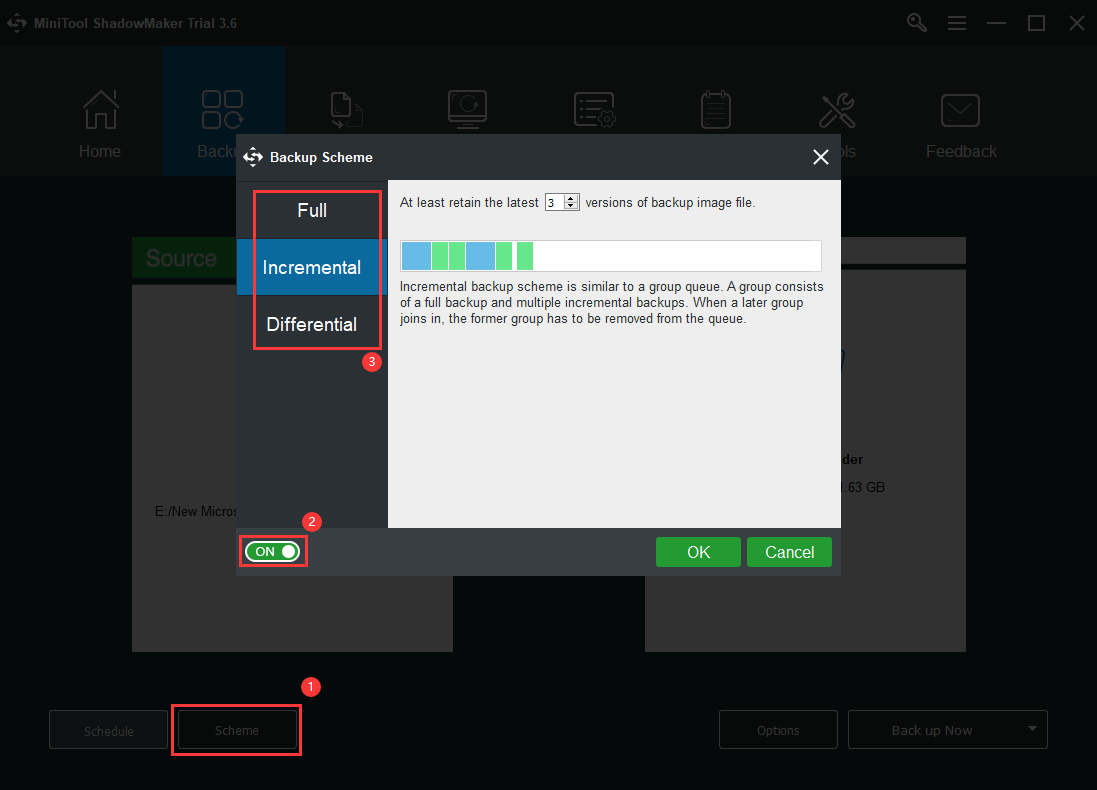
You can skip this step and create an initial backup (full backup by default) first. Then, set up a backup method for this backup task in the Manage tab.
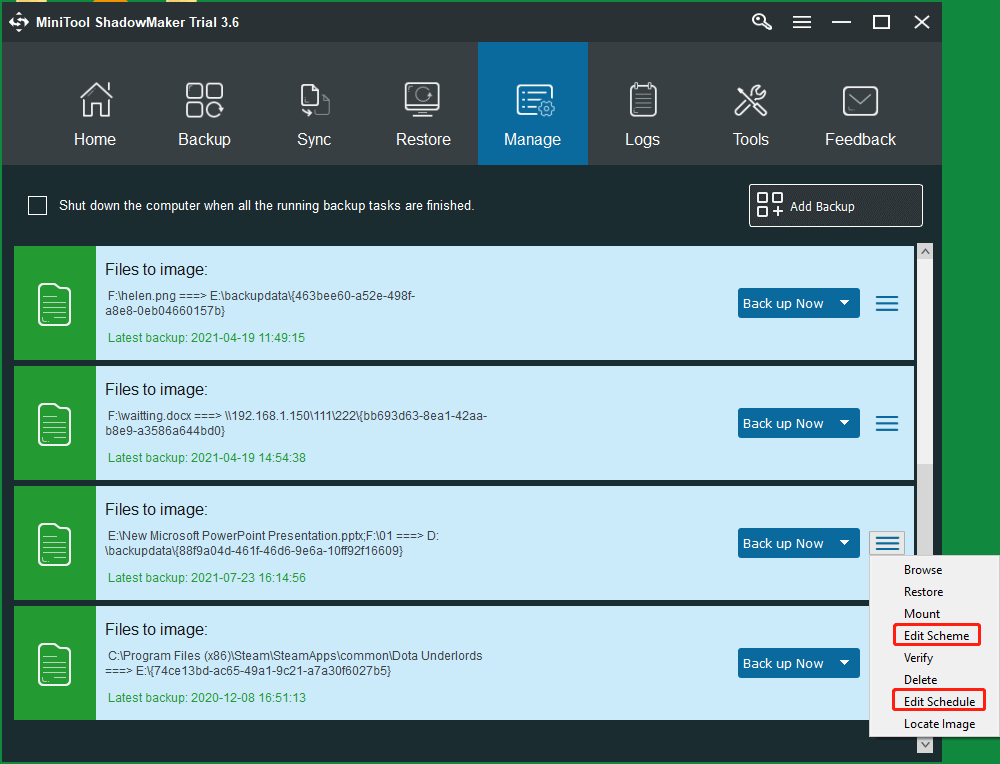
8. Furthermore, you can manage the hot backup version with the Options button, locating in the lower right of the Backup screen. After triggering the options window, you can find out all the settings you can make to your backup: backup image files size, image compression, comment to the backup image, excluding certain files from backup, image encryption, image integrity verification, etc. Also, if you don’t care about these settings, just move to the next step.

9. Finally, click the Back up Now button in the bottom right corner of the Backup screen. It will start to back up your data.
In addition to data backup and restoration, MiniTool ShadowMaker also enables you to sync files between two locations, build bootable media for crashed computers, clone data from one disk to another, boot multiple computers from microsystem in the network, and so on.
Hot Backup vs Cold Backup – Conclusion
Backup is an important part of data protection today. No one can afford to lose data. You can opt for either cold backup or hot backup for your data relying on your own situation, no matter you are running a business or just a personal user.
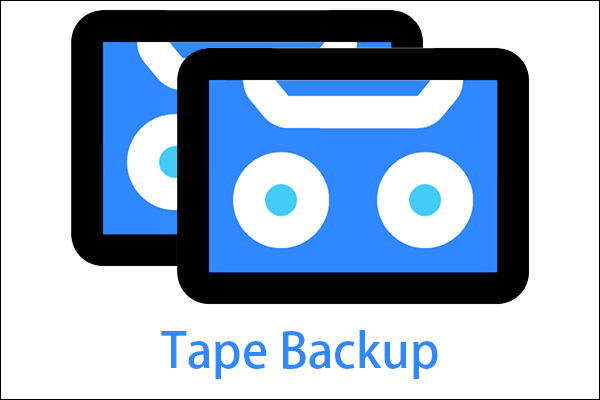
![[Solved] How to Backup WordPress Site and Database?](https://images.minitool.com/minitool.com/images/uploads/2020/11/how-to-backup-wordpress-site-thumbnail.png)

